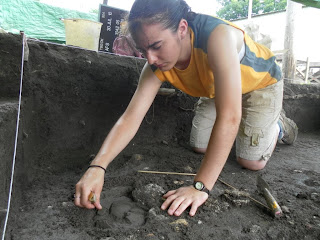 |
| Photo of Megan Anderson by Dan Ritt with the Slobodna Field School, PAST Foundation, Summer 2010. |
Archaeology is already one of the coolest-sounding professions out there; add a wetsuit and an air tank and it probably surpasses those of “spy” and “astronaut.” This summer I was privileged to attend the
Slobodna Underwater Archaeology Field School with the PAST Foundation off the coast of Key Largo, FL. The
Slobodna was a down-easter composite ship that was carrying cotton when she ran into the reef; a few years later, a hurricane dragged the ship and deposited it in three separate locations. The Mainmast site, where I was working, now lies off the coast of Key Largo 15-30 feet below the surface. This area was littered with pins, hull plating, sections of the keel and mast, and spar rings.
Every morning for two weeks, I got to jump out of a boat with an underwater slate and measuring tape in hand. Doing archaeology underwater is an almost indescribable experience. You have to have a telepathic connection to your team members, as the only sound you hear as you work is the hiss of your regulator and the occasional growl of a damsel fish. It’s like visiting an alien world: everything is dipped in blue light and the artifacts are ghostly things, misshapen by several hundred years of concretions and coral.
The limitations that scuba imposes on underwater archaeology are sometimes frustrating. Sometimes, after only two hours at the site, we would return to the dormitory only to realize that we had forgotten some crucial measurement that would prohibit us from being able to map out an artifact, or we would find that a section of pencil marks had been rubbed off the waterproof mylar. We couldn't just hop back down to the site or extend our time at the site the next day. However, the excitement of finally figuring out what a particular artifact was, or locking in the coordinates of an artifact onto the master site map, made up for these minor inconveniences.
Working underwater is unlike anything I've ever done. Your life depends on your team, and you count on them to get you untangled, share air if something goes wrong, and stop you from brushing up against fire coral with your bare skin. I have found my passion in underwater archaeology, and in the future I plan to study and protect underwater sites as well as present them to the public.
Click
here to read about Megan's experiences at the Rio Bravo Field School in Belize this summer.

















